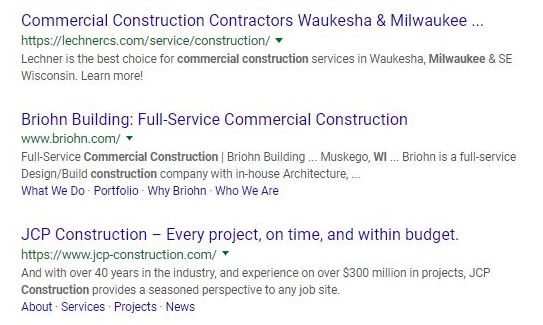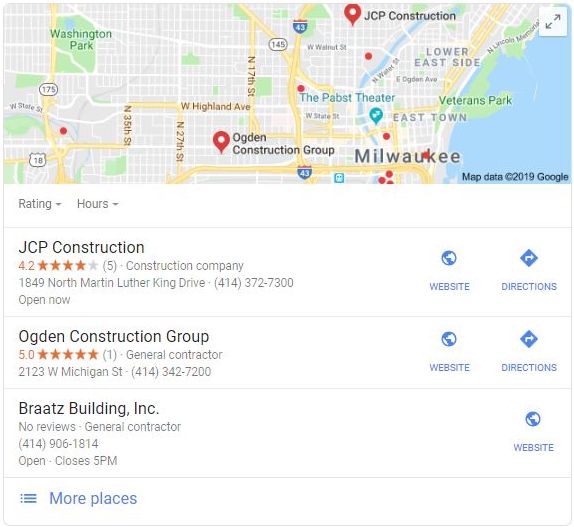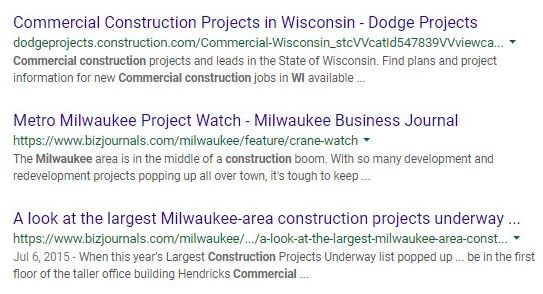When people think about showing up in the search results, they often think about those 10 spots on the first page. Ideally, you would like your business to fill as many of those positions as possible. After all, every spot your business fills on the first page is one less position for competing businesses. And if you can also get some prominent positioning, that’s even better.
In this post, we’re going to look at the different search results positions that exist and why each one is important…
Direct Link in the Top 10 Listings
These 10 spots on the first page of the search results are often referred to as the organic search results. And, as I mentioned earlier, this is the part of the results page that most businesses are concerned about when someone says, “we want to be at the top of the search results.”
Recently, I conducted some free research for a prospect to analyze their online positioning along with their competitors. The examples in this post are from that research. In this case, I searched for “commercial construction milwaukee”. This block of 3 results below show you an example of direct links to the businesses.

This is the part of the search results that has traditionally been influenced by search engine optimization (SEO). When you perform search engine optimization, or hire a company to do this for you, changes are made on the site and offsite to help teach the search engines that your business belongs in a top spot for various searches.
On the Map or Business Profile
You’ve performed searches in the past where you’ve seen businesses showing up with a map. When your search indicates the need for a local business, Google shows a small map and, typically, 3 businesses on the map, with a More Places button that will bring up more options if you need to see more than the initial set.
This is a very important part of the search results which often, though not always, shows at or near the top of the page. There are a variety of nicknames for this part of the search results, but I like to call it the Money Zone, because this area is so visible that searchers are likely to click to learn more.
The great thing is, that a click does not have to go to your website. Searchers can also click to get directions to your location. And if they’re on a mobile phone, they can click to make a phone call. Google makes it easy.
For the same search as above, “commercial construction milwaukee”, this image below shows the Money Zone with three businesses represented. In this case, the map and these businesses are featured ahead of the direct links in the search results. Not only is the placement prominent, but the map itself grabs attention because it doesn’t look like the rest of the search results.

Related to the map listing is the side panel business profile. Sometimes, instead of showing the Money Zone with three businesses, Google will feature a single business with more business details showing. In this case the information is featured in a profile panel to right of the normal search results.
Though the map and profile sections are completely different placements in the search results, I consider them a single way to show up. The reason for this is that the two positions are mutually exclusive. If there is a Money Zone with some businesses in the main search column, there is no business profile panel. Likewise, if there is a business featured to the right, then there is no business shown with a map.
Also, in either case, the qualifications to appear are basically the same. To begin, your business needs a Google My Business listing. This is a free listing. You simply have to claim your business and provide some details to Google.
Beyond that, Google’s algorithm determines which businesses show up in which search results. And this is determined by three factors — relevance, distance, and prominence.
First, relevance is how closely the business listing matches the search words given. The more Google knows about your business, the more your business can show up with relevant searches.
Second, distance is pretty straight forward. How near or far is your business from the searcher’s current location or the location words they used in their search?
Third, prominence, which I like to call popularity, refers to how well-known your business is in the marketplace for various searches. A popular establishment is much more likely to show up than one that is relatively unknown. And, according to Google, “more reviews and positive ratings will probably improve a business’s local ranking.”
What did Google say about reviews? More is better, and strong ratings are better. These combine to improve the ranking of a business on the map. So, if you would like a good position on the map, you must get great Google reviews.
Indirect Links in the Top 10 Listings
This is part of the search results that many businesses overlook. They don’t think about the extreme value of an indirect link.
What do I mean by an indirect link? This means that the search result does not point directly to your business website. Instead it points to another website. These are links that belong to someone else, another business or person.
One example of these indirect links could include directories such as Yelp and Manta. These are sites that include business listings and can be searched by location and industry. For some searches, one or more of these directories will appear on the search results page. If the searcher clicks, they may see your business, get information about your business, and then take follow-up action to click to your website or call directly.

Another example of indirect links would include organizations that your business might have joined, such as a Chamber of Commerce or the Better Business Bureau. These organizations may publish enough information about your business that their listing of your business can show when someone does an appropriate search. Not only is the indirect link good, but the searcher also realizes that you have another organization standing beside your business. That can offer a little extra credibility.

Then there are “intentional” third-party sites. These are websites where you may have sought to show up, kind of like directories, except in this case you are publishing specific information about your business. A good example of this is an online press release. You can write and submit press releases to a number of online organizations that will publish the release on their sites. Therefore, if your press release is relevant to someone’s search, a link to the press release page may show up in the search results. In this case, the link will take the searcher to a page that contains good information about your company, but it is not your company’s website, rather it is the site of the publisher.
Finally, there are “unintentional” third-party sites. Typically these could be positive or negative comments about your business that someone posts on a blog or some other public forum. The information is out there, whether you know it or not, and someone might come across it in a search. While this type of indirect appearance may not have a link to your site, a mention might be enough so that the searchers goes back to the search to find your company by name.
Regardless of how the indirect link was created, when these appear in the search results, they can lead searchers back to your business. They might not be as good as direct links, but they do remain an effective way to be seen online. The list below comes from the same search results page as the direct links and map links shown above.

For Google, including these results is important because these sites provide additional information that can help a searcher find what they are looking for.
Where Should Your Business Be Seen in the Search Results?
What do you think… the traditional organic top 10 search positions with direct links, the map with its eyeball-grabbing placement, or within indirect links where someone else is featuring your business?
The good news is that you do not have to pick one. There is value in all three positions, so go for all three! If you’re successful, your business can easily occupy more than a single position on the first page of the search results.
Getting businesses to show in these three parts of the search results is the focus of our Authority Visibility System. This process attracts the attention of authority websites that Google already loves. When they publish information about your business, you get indirect links very quickly. When these sites link to your own, providing good information about your business, your organic search profile improves so that your direct links become more visible. Finally, with these organizations talking about your business, prominence improves to support and boost your position on the map.
While many people talk about SEO, there’s often a better way. If you might be interested in improving the online visibility of your business, take a look at this page and go on from there. You can even request that we provide you with free research about your business and competitors so you’ll know what steps to take to achieve better online results.

